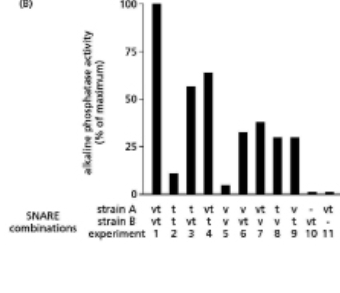v-SNAREs and t-SNAREs mediate the recognition of a vesicle at its target membrane so that a vesicle displaying a particular type of v-SNARE will only fuse with a target membrane containing a complementary type of t-SNARE.In some cases, v-SNAREs and t-SNAREs may also mediate the fusion of identical membranes.In yeast cells, right before the formation of a new cell, vesicles derived from the vacuole will come together and fuse to form a new vacuole destined for the new cell.Unlike the situation we have discussed in class, the vacuolar vesicles contain both v-SNAREs and t-SNAREs.Your friend is trying to understand the role of these SNAREs in the formation of the new vacuole and consults with you regarding the interpretation of his data.
Your friend has designed an ingenious assay for the fusion of vacuolar vesicles by using alkaline phosphatase.The protein alkaline phosphatase is made in a "pro" form that must be cleaved for the protein to be active.Your friend has designed two different strains of yeast: strain A produces the "pro" form of alkaline phosphatase (pro-Pase), whereas strain B produces the protease that can cleave pro-Pase into the active form (Pase).Neither strain has the active form of the alkaline phosphatase, but when vacuolar vesicles from the strains A and B are mixed, fusion of vesicles generates active alkaline phosphatase, whose activity can be measured and quantified (Figure 15-9A). (A)

Figure 15-9
Your friend has taken each of these yeast strains and further engineered them so that they express only the v-SNAREs, only the t-SNAREs, both SNAREs (the normal situation), or neither SNARE.He then isolates vacuolar vesicles from all strains and tests the ability of each variant form of strain A to fuse with each variant form of strain B, by using the alkaline phosphatase assay.The data are shown in the graph in Figure 15-9B.On this graph, the SNARE present on the vesicle of the particular yeast strain is indicated as "v" (for the presence of the v-SNARE) and "t" (for the presence of the t-SNARE).
What do his data say about the requirements for v-SNAREs and t-SNAREs in the vacuolar vesicles? Is it important to have a specific type of SNARE (that is, v-SNARE or t-SNARE) on each vesicle?
Definitions:
Interaction
A reciprocal action or influence between entities, objects, persons, or other variables.
Personality Traits
Enduring characteristics that describe an individual's consistent behaviors, thoughts, and emotional patterns.
Swimmers
Athletes who engage in the sport or activity of moving through water by using their limbs.
Physiological Tests
Examinations conducted to assess the physical functions of the body in order to diagnose diseases or monitor health conditions.
Q1: You have purified DNA from your recently
Q7: Which of the following statements is FALSE?<br>A)Cdc25
Q10: Using genetic engineering techniques, you remove the
Q10: Indicate whether a cDNA library or a
Q12: Mouse embryonic stem (ES) cells<br>A)can only be
Q21: Anemia, a condition that results in individuals
Q27: Throughout history,fixed sentences have totally dominated criminal
Q30: Which of the following statements is TRUE?<br>A)Ubiquinone
Q51: Progression through the cell cycle requires a
Q59: Which of the following statements about G-protein-coupled